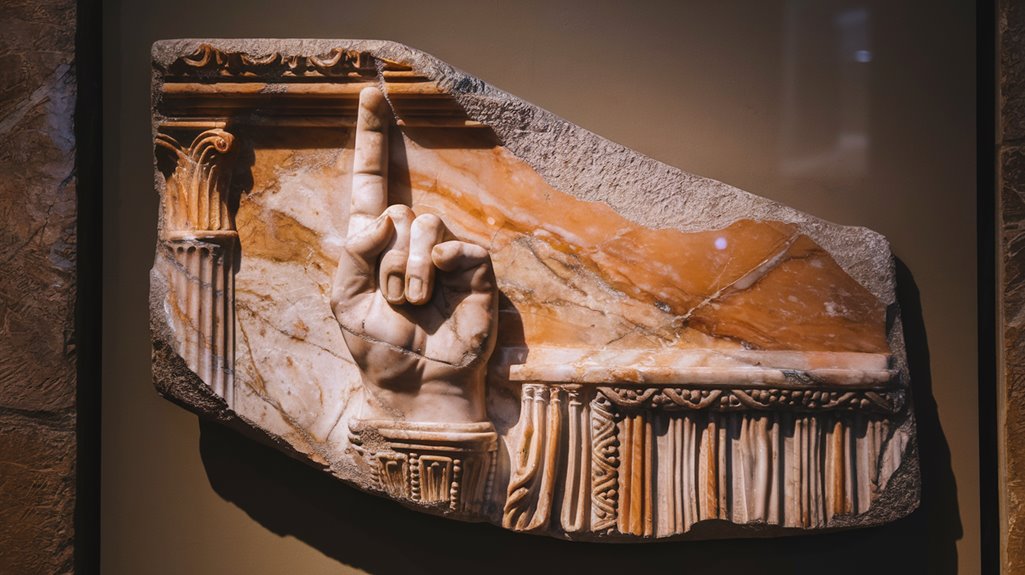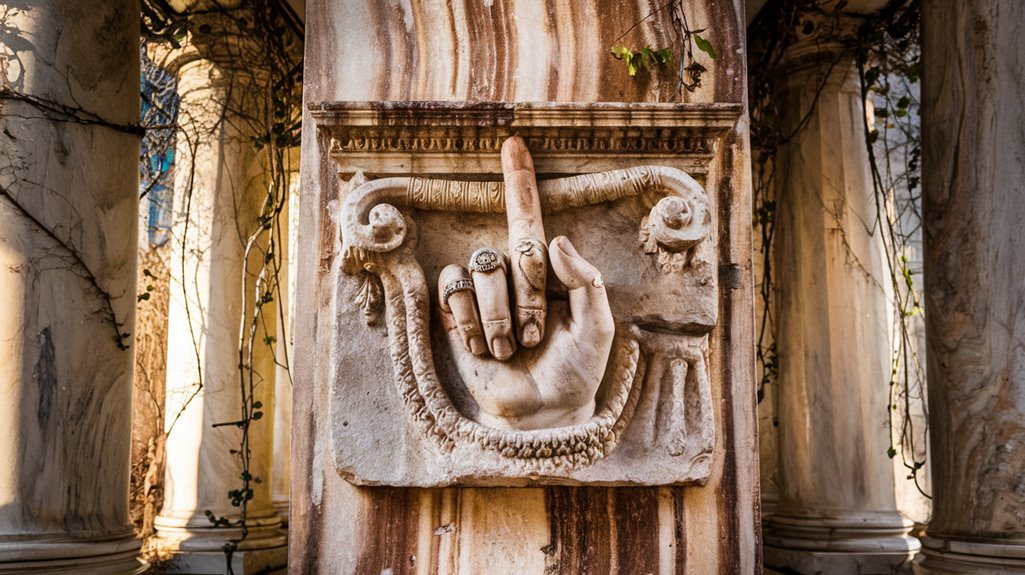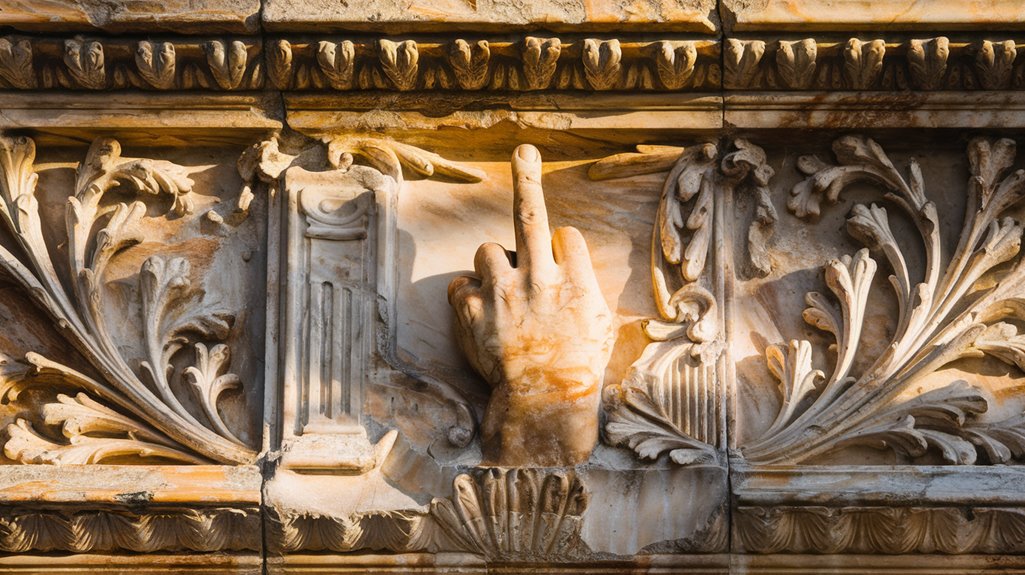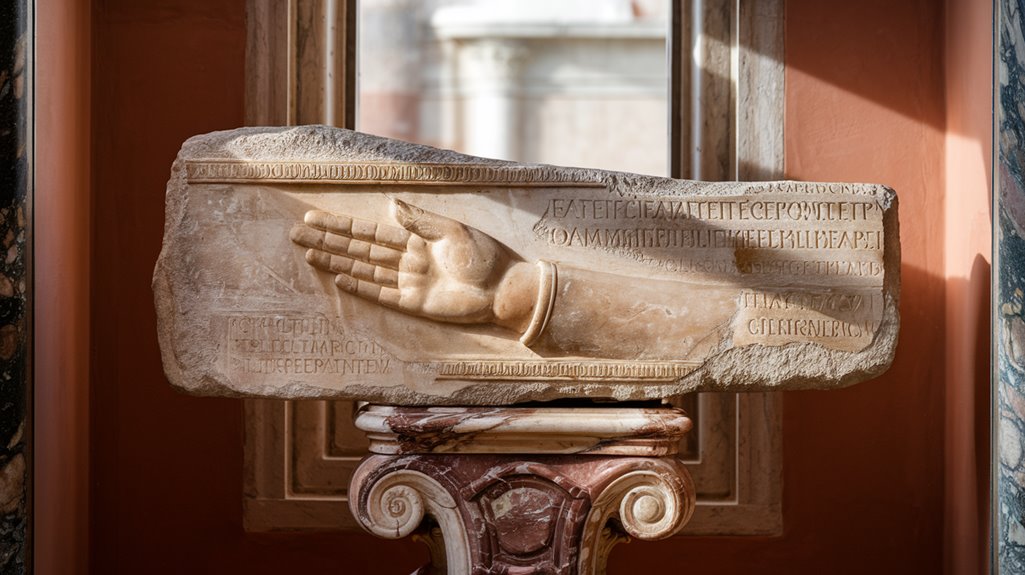The Middle Finger’s Ancient Roman Beginnings
Just like a pebble tossed into a pond creates ripples that extend far beyond its point of impact, you'll find the middle finger's journey through time begins with a surprising splash in ancient Rome. You've probably flashed this gesture yourself, but its rich history as the "digitus impudicus" carries more weight than you'd expect. From emperors wielding it as a tool of dominance to its role in Roman theater, this simple finger movement tells a fascinating story of power, defiance, and cultural evolution.
The Digitus Impudicus: Origins in Ancient Rome

The notorious middle finger gesture, known in ancient Rome as the "digitus impudicus," carries a rich history dating back over two millennia.
You'll find this ancient insult documented extensively in Roman texts, where it served as a powerful form of gestural symbolism representing both sexual aggression and contempt.
When you examine historical accounts, you'll discover that even emperors weren't above using this offensive gesture. German tribes frequently directed this defiant signal at Roman soldiers during battles.
Caligula notoriously forced subjects to kiss his middle finger, while Augustus Caesar once punished an actor for directing it at an audience member.
The ancient Greeks first established the gesture as an apotropaic sign to ward off evil spirits.
The gesture's anatomical symbolism wasn't subtle – Romans viewed the extended middle finger flanked by curved fingers as representing the phallus and testicles.
This interpretation helped establish the digitus impudicus as one of history's most enduring and universally recognized expressions of disrespect.
Imperial Reactions and Cultural Impact
While Roman society generally tolerated various forms of expression, imperial reactions to the middle finger gesture proved remarkably severe.
You'll find evidence of this in Augustus Caesar's harsh response when he banished an actor named Pylades from Rome for using the gesture against a heckler. This display of imperial authority set a precedent for how seriously Romans viewed the offense.
The gesture's cultural morality implications ran deep, as demonstrated by Caligula's cruel practice of forcing subjects to kiss his middle finger as a form of humiliation. Similar to how structured learning sequences were carefully designed for education, Roman authorities developed systematic responses to this offensive gesture.
The middle finger was considered so vulgar that Romans referred to it as the digitus impudicus, which directly translates to "indecent finger."
You can see how the digitus impudicus became more than just an offensive gesture – it evolved into a tool of power and control. The consequences of using it weren't just social; they could result in legal punishment or exile.
Roman Literature and Documented Evidence
Ancient Roman literature provides compelling evidence of the middle finger's role as a potent insult, with notable references appearing in Martial's Epigrammata and Isidore's Etymologiae.
You'll find rich literary symbolism in these texts, where writers describe the gesture using terms like digitus impudicus (shameless finger) and infami digito.
The cultural nuances become clear when you examine how authors like Martial depicted the gesture in various scenarios, such as confrontations with doctors.
In Aristophanes's earlier work "The Clouds," you'll notice how the middle finger gesture appears alongside other crude displays, suggesting its established role in ancient society.
These documented references don't just record the gesture's existence – they reveal its consistent association with sexual aggression, mockery, and social defiance throughout Roman history.
From Greek Comedy to Roman Society
Moving from Greek comedy stages to Roman streets, the middle finger gesture underwent a fascinating cultural transformation that shaped its enduring legacy.
You'll find its roots in Greek satire, where philosophers and performers used it to mock opponents and symbolize male genitalia. The Greeks called it "katapugon," linking it to sexual submission and insult.
When this cultural symbolism reached Rome, it evolved from a positive symbol that could ward off evil spirits into the infamous "digitus impudicus" – the shameless finger. Ancient Romans viewed the middle finger as a protective good luck charm.
You can trace this shift through Roman emperors like Octavian Augustus, who strictly punished those who used it. The gesture's meaning deepened through Roman society, with actors and politicians wielding it as a powerful tool of disrespect and criticism.
The Legacy of Rome's Infamous Gesture

Throughout history, Rome's "digitus impudicus" has evolved from a protective symbol into one of the world's most recognized gestures of defiance.
You'll find its cultural symbolism deeply rooted in ancient Roman society, where it shifted from warding off evil spirits to becoming a powerful insult.
The gesture's enduring impact on social etiquette and communication spans centuries, crossing cultural and linguistic barriers.
Here's how Rome's infamous gesture has shaped modern society:
- The Catholic Church's medieval disapproval cemented its status as taboo
- Its theatrical use in Roman plays influenced modern entertainment
- Emperor Caligula's degrading practices reinforced its insulting nature
- Its universal recognition demonstrates the lasting power of Roman cultural influence
Today, you'll recognize this ancient gesture's presence in everything from movies to political protests, proving Rome's lasting impact on nonverbal communication.










